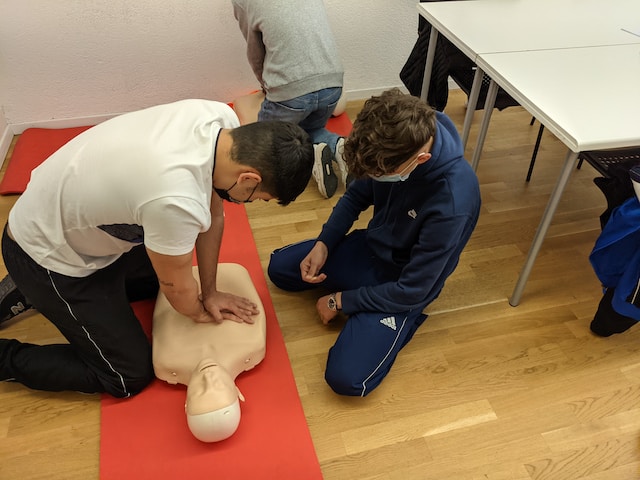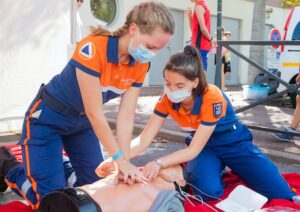What You Need to Become a Certified First-Aider

Are you ready to be a hero in times of crisis? Becoming a certified first-aider can give you the skills and knowledge needed to save lives and provide immediate assistance during emergencies. Whether it’s at home, work, or in public spaces, having the ability to respond effectively can make all the difference. In this blog post, we will explore what it takes to become a certified first-aider. From training courses to essential skills, we’ll guide you through the steps necessary to join the ranks of these everyday heroes. So grab your medical kit, and let’s dive right in.
Training Course
 When it comes to becoming a certified first-aider, one of the key steps is completing a training course. These courses provide individuals with the necessary skills and knowledge needed to handle various medical emergencies. During the training course, participants learn about different types of injuries, such as burns, fractures, and bleeding. They also gain an understanding of how to assess a situation quickly and prioritize treatment based on the severity of injuries.
When it comes to becoming a certified first-aider, one of the key steps is completing a training course. These courses provide individuals with the necessary skills and knowledge needed to handle various medical emergencies. During the training course, participants learn about different types of injuries, such as burns, fractures, and bleeding. They also gain an understanding of how to assess a situation quickly and prioritize treatment based on the severity of injuries.
One crucial aspect covered in these courses is cardiopulmonary resuscitation (CPR). Participants are taught how to perform CPR correctly in order to revive someone whose heart has stopped beating. BLS is often included in these courses, which teaches participants how to respond to cardiac and respiratory emergencies. Some people have preferred to pursue ACLS. If you already have one and want to renew it, consider acls recert online.
First Aid Skills
When it comes to becoming a certified first-aider, acquiring essential first-aid skills is crucial. These skills are the foundation for providing immediate care and assistance to those in need during emergencies or accidents. One of the key skills you’ll learn in a first aid training course is CPR (Cardiopulmonary Resuscitation). This life-saving technique helps to maintain blood circulation in someone who has suffered cardiac arrest. Additionally, learning how to perform the Heimlich maneuver can help dislodge an obstruction from someone’s airway. Another important skill that first-aiders should possess is the ability to control bleeding. This may involve applying direct pressure on wounds or using tourniquets if necessary.
Knowledge of First Aid Principles
When it comes to becoming a certified first-aider, having knowledge of first-aid principles is essential. First aid principles serve as the foundation for providing effective and timely assistance in emergencies. One of the key aspects of first aid principles is understanding how to assess a situation quickly and accurately. This involves being able to identify potential dangers or hazards, as well as determining the severity of injuries or illnesses. By having this knowledge, you can make informed decisions about what actions need to be taken. Equally important is knowing how to prioritize care based on the seriousness of each condition. For example, if someone is experiencing severe bleeding, they would require immediate attention compared to someone with a minor cut.
Written Test
 After completing the training course and acquiring first aid skills, there is one final hurdle to becoming a certified first-aider: the written test. This assessment evaluates your knowledge of first aid principles and ensures that you are fully prepared to handle various emergencies. The written test consists of multiple-choice questions that cover a wide range of topics related to first aid.
After completing the training course and acquiring first aid skills, there is one final hurdle to becoming a certified first-aider: the written test. This assessment evaluates your knowledge of first aid principles and ensures that you are fully prepared to handle various emergencies. The written test consists of multiple-choice questions that cover a wide range of topics related to first aid.
It assesses your understanding of procedures for treating different injuries, recognizing symptoms of common medical conditions, and administering CPR effectively. To pass the written test, it is essential to review all the material covered during the training course thoroughly. Make sure you understand key concepts such as assessing vital signs, providing basic wound care, immobilizing fractures, and managing head injuries. During the test, remember to read each question carefully before selecting an answer. Take your time and think critically about each scenario presented. Please don’t rush through it; accuracy is crucial in this assessment.
Conclusion
So why wait? Take action today by enrolling in a recognized first-aid training program near you! Start your journey towards becoming certified – making yourself invaluable when unexpected emergencies strike. Remember: every second counts when it comes to saving lives. We hope that you have found this blog post helpful.
